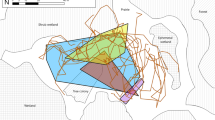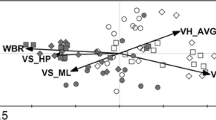Abstract
Termites, and in particular species that remove live plant material, play an important role in rangeland deterioration in the arid areas of the world. In the arid parts of southern Africa, where the sparse vegetation is important for subsistence and large-scale game farming, it is vital to understand termite ecology and feeding behaviour. Here, we focus on the termite species, Baucaliotermes hainesi, the most common termite species within its range in the arid interior of southern Africa. We determine B. hainesi foraging and nest maintenance activities, predator response and the preferred food plants. The study was conducted during 2014 in the Nama-Karoo biome of South Africa. We found that Baucaliotermes hainesi is strictly a nocturnal species and that temperature is the most important abiotic determinant of foraging activity. Below 14 °C, no foraging takes place, whilst maximum foraging activity is observed only above 20 °C. Only three plant species are foraged upon, with the grass Stipagrostis uniplumis utilised the most. We suggest that B. hainesi can significantly reduce grass cover, particularly in overgrazed areas and in dry years. Further studies to elucidate the effects of drought, overgrazing and the role of B. hainesi in veld degradation are critical, in particular under future climate scenarios that the predict aridification of B. hainesi habitat.



Similar content being viewed by others
References
Adam RA, Mitchell JD, van der Westhuizen MC (2005) Food preferences in laboratory colonies of the harvester termite, Trinervitermes trinervoides (Sjöstedt) (Termitidae: Nasutitermitinae). Afr Entomol 13:193–200
Adam RA, Mitchell JD, van der Westhuizen MC (2008) Aspects of foraging in the harvester termite, Trinervitermes trinervoides (Sjöstedt) (Termitidae: Nasutitermitinae). Afr Entomol 16:153–161
Adam RA, Mitchell JD, van der Westhuizen MC (2012) The role of the harvester termite, Trinervitermes trinervoides (Termitidae: Nasutitermitinae), in a semi-arid grassland ecosystem in South Africa: Nest populations and caste composition. Afr Entomol 20:239–251
Anderson MD (2004) Aardwolf adaptations: a review. Trans R Soc South Afr 59:99–104
Basson NCJ (1972) Beskadiging van natuurlike weiveld in die Noord-Vrystaat deur die grasdraertermiet, Hodotermes mossambicus (Hagen). Phytophylactica 4:67–72
Becker T, Getzin S (2000) The fairy circles of Kaokoland (North-West Namibia)—origin, distribution, and characteristics. Basic Appl Ecol 1:149–159
Bodin Ö, Tengö M, Norman A, Lundberg J, Elmqvist T (2006) The value of small size: loss of forest patches and ecological thresholds in southern Madagascar. Ecol Appl 16:440–451
Coaton WGH (1948a) Trinervitermes species—the snouted harvester termite. Union South Afr Dep Agric Bull 261:1–19
Coaton WGH (1948b) The snouted harvester termite. Farming South Afr 23:97–106
Coaton WGH (1953) Termites and their control in cultivated areas in South Africa. Union of South Africa, Department of Agriculture, Division of Entomology, Bulletin No. 305, Pretoria
Coaton WGH (1958) The hodotermitid harvester termites of South Africa. Dep Agric Sci Bull South Afr Entomol Ser 375:431–512
Coaton WGH, Sheasby JL (1973) National survey of the Isoptera of southern Africa. 1. The genus Baucaliotermes Sands (Termitidae: Nasutitermitinae). Cimbebasia Ser A 3:1–7
Dangerfield JM, McCarthy TS, Ellery WN (1998) The mound-building termite Macrotermes michaelseni as an ecosystem engineer. J Trop Ecol 14:507–520
Darlington JPEC (1982) The underground passages and storage pits used in foraging by a nest of the termite Macrotermes michaelseni in Kajiado, Kenya. J Zool Lond 198:237–247
Derichs P, du Plessis N (2012) Flowering plants of the Augrabies Falls National Park
Dougill AJ, Akanyang L, Perkins JS, Eckardt FD, Stringer LC, Favretto N, Atlhopheng J, Mulale K (2016) Land use, rangeland degradation and ecological changes in the southern Kalahari, Botswana. Afr J Ecol 54:59–67
Duncan FD, Hewitt PH (1989) Observations on the foraging behaviour of the harvester termite, Hodotermes mossambicus (Hagen) (Isoptera: Hodotermitidae). Bull Entomol Res 79:631–642
Eggleton P (2000) Global patterns of termite diversity. In: Abe T, Bignell DE, Higashi M (eds) Termites: evolution, sociality, symbioses, ecology. Kluwer Academic Publishers, Dordrecht, pp 25–51
Fuller C (1922) The termites of South Africa. S Afr J Nat Hist 3:70–131
Grohmann C (2010) Termite mediated heterogeneity of soil and vegetation patterns in a semi‐arid savanna ecosystem in Namibia. Ph.D Dissertation, Julius‐Maximilians University of Würzburg, Würzburg
Hager FA, Kirchner WH (2013) Vibrational long-distance communication in the termites Macrotermes natalensis and Odontotermes sp. J Exp Biol 216:3249–3256
Hager FA, Kirchner WH (2014) Directional vibration sensing in the termite Macrotermes natalensis. J Exp Biol 217:2526–2530
Harris WV (1971) Termites: their recognition and control. Longman, Bristol
Hartwig EK (1955) Control of snouted harvester termites. Farming South Afr 30:361–366
Haverty MI (1977) The proportion of soldiers in a termite colonies: a list and a bibliography (Isoptera). Sociobiology 2:199–216
Heidecker JL, Leuthold RH (1984) The organisation of collective foraging in the harvester termite Hodotermes mossambicus (Isoptera). Behav Ecol Sociobiol 14:195–202
Hoffman MT, Ashwell A (2001) Nature divided: land degradation in South Africa. University of Cape Town Press, Cape Town
IPCC (2001) Climate change 2001: The scientific basis. Contribution of Working Group I to the Third Assessment Report of the Intergovernmental Panel on Climate Change. Houghton JT, Ding Y, Griggs DJ, Noguer M, van der Linden PJ, Dai X, Maskell K., Johnson CA (eds.) Cambridge University Press, Cambridge and New York
Jones CG, Lawton JH, Shachak M (1994) Organisms as ecosystem engineers. Oikos 69:373–386
Jouquet P, Dauber J, Lagerlöf J, Lavelle P, Lepage M (2006) Soil invertebrates as ecosystem engineers: intended and accidental effects on soil and feedback loops. Appl Soil Ecol 32:153–164
Kambhampati S, Eggleton P (2000) Taxonomy and phylogeny of termites. In: Abe T, Bignell DE, Higashi M (eds) Termites: evolution, sociality, symbioses, ecology. Kluwer Academic Publishers, Dordrecht, pp 1–23
Koehler CE, Richardson PRK (1990) Proteles cristatus. Mammalian Species. Am Soc Mammal 363:1–6
Kofoid CA (1934) Climate factors affecting the local occurrence of termite and their geographical distribution. In: Kofoid CA (ed) Termites and termite control. University of California Press, Berkeley, pp 13–21
Krishna K, Grimaldi DA, Krishna V, Engel MS (2013) Treatise on the Isoptera of the world. Bull. Am. Mus. Nat. Hist. 377:1–2704
Le Roux A (2005) South African Wildflower Guide No. 1: Namaqualand. Botanical Society of South Africa
Leuthold RH, Bruinsma O, van Huis A (1976) Optical and pheromonal orientation and memory for homing distance in the harvester termite Hodotermes mossambicus (Hagen). Behav Ecol Sociobiol 1:127–139
McMahan EA (1963) A study of termite feeding relationship using radio-isotopes. Ann Entomol Soc Am 56:74–82
Midgley G, Rutherford M, Bond W (2001) The heat is on…; impacts of climate change on plant diversity in South Africa. National Botanical Institute, Cape Town, South Africa
Mirenda JT, Eakins DG, Gravelle K, Topoff H (1980) Predatory behavior and prey selection by army ants in a desert-grassland habitat. Behav Ecol Sociobiol 7:119–127
Mouton PFN, Geertsema H, Visagie L (2000) Foraging mode of a group-living lizard, Cordylus cataphractus (Cordylidae). Afr Zool 35:1–7
Mucina L, Rutherford MC (eds) (2006) The Vegetation of South Africa, Lesotho and Swaziland. Strelitzia 19. South African National Biodiversity Institute, Pretoria
Muller K, Ward D (2013) Direct and indirect effects of termites on savanna tree-seedling growth. Plant Ecol 214:811–819
Nel JJC (1968) Die grasdraertermiet, Hodotermes mossambicus (Hagen), as plaag van natuurlike weiveld. J Entomol Soc South Afr 31:309–321
Nel JJC, Hewitt PH (1969) A study of the food eaten by a field population of the harvester termite, Hodotermes mossambicus (Hagen) and its relation to population density. J Entomol Soc South Afr 32:123–131
Ohiagu CE (1979a) Nest and soil populations of Trinervitermes spp. with particular reference to T. geminatus (Wasmann) (Isoptera), in Southern Guinea Savanna near Mokwa. Nigeria. Oecologia 40:167–178
Ohiagu CE (1979b) A quantitative study of seasonal foraging by the grass harvesting termite, Trinervitermes geminatus (Wasmann) (Isoptera, Nasutitermitinae), in Southern Guinea Savanna, Mokwa, Nigeria. Oecologia 40:179–188
Ohiagu CE, Wood TG (1976) A method for measuring rate of grass-harvesting by Trinervitermes geminatus (Wasmann) (Isoptera, Nasutitermitinae) and observation on its foraging behaviour in Southern Guinea Savanna, Nigeria. J Appl Ecol 13:705–713
Okullo P, Moe SR (2012) Termite activity, not grazing, is the main determinant of spatial variation in savanna herbaceous vegetation. J Ecol 100:232–241
Olugbemi BO (2010) Influence of food on recruitment pattern in the termite, Microcerotermes fuscotibialis. J Insect Sci 10:154
Olugbemi BO, Malaka SLO (2007) The effect of food on pheromonal communication in the termite, Microcerotermes fuscotibialis Sjostedt. Afr J Ecol 45:216–219
Pomeroy DE (1976) Some effects of mound-building termites on soils in Uganda. J Soil Sci 27:377–394
Richardson PRK (1987) Aardwolf: the most specialized myrmecophagous mammal? South Afr J Sci 83:643–646
Sands WA (1961) Foraging behaviour and feeding in five species of Trinervitermes in West Africa. Entomol Exp Appl 4:277–288
Sands WA (1965) A revision of the termite subfamily Nasutitermitinae (Isoptera, Termitidae) from the Ethiopian region. Bull Br Mus Nat Hist Entomol Suppl 4:1–172
Šobotník J, Jirošová A, Hanus R (2010) Chemical warfare in termites. J Insect Physiol 56:1012–1021
Støen OG, Okullo P, Eid T, Moe SR (2013) Termites facilitate and ungulates limit savanna tree regeneration. Oecologia 172:1085–1093
Taylor WA, Lindsey PA, Skinner JD (2002) The feeding ecology of the aardvark Orycteropus afer. J Arid Environ 50:135–152
Thorne BL (1982) Polygyny in termites: multiple primary queens in colonies of Nasutitermes corniger (Motschuls) (Isoptera: Termitidae). Insect Soc 29:102–117
Tschinkel WR (2010) The foraging tunnel system of the Namibian desert termite, Baucaliotermes hainesi. J Insect Sci 10:1–17
Turner JS, Marais E, Vinte M, Mudengi A, Park WL (2006) Termites, water and soils. Agricola 16:40–45
Urban EK, Fry CH, Keith S (1986) The Birds of Africa, vol 2. Academic Press, London
Uys V (2002) A guide to the termite genera of southern Africa. Plant Protection Research Institute, Handbook No. 15, Agricultural Research Council, Pretoria
Van Ark H (1969) Control of Hodotermes mossambicus in the Karroo (Hodotermitidae, Isoptera). Phytophylactica 1:41–50
Verma M, Sharma S, Prasad R (2009) Biological alternatives for termite control: a review. Int Biodeterior Biodegrad 63:959–972
Whitford WG, Ludwig JA, Noble JC (1992) The importance of subterranean termites in semiarid ecosystems in South-Eastern Australia. J Arid Environ 22:87–91
Acknowledgments
We thank Henriëtte van der Linden, Dawie Snyman and Martin de Wit for assistance with fieldwork and comments on an earlier draft. We are grateful to Brigitte Braschler for assistance with ant identification. We thank the landowners, Isak and Hannes Nel, for permission to work on the farm Tierkop. We thank two anonymous reviewers and Yves Roisin whose suggestions helped improve and clarify this manuscript. SG acknowledges support from the National Research Foundation (Grant 87843).
Author information
Authors and Affiliations
Corresponding author
Electronic supplementary material
Below is the link to the electronic supplementary material.
40_2016_488_MOESM3_ESM.mp4
Video 2. An ant, of the species Tetramorium grandinode (subfamily Myrmicinae), caught a Baucaliotermes hainesi soldier then encounters the foraging column again and makes a quick turnaround. (MP4 4660 kb)
40_2016_488_MOESM4_ESM.mp4
Video 3. Baucaliotermes hainesi soldiers squirting turpentine at an insect that landed close to a foraging column. (MP4 3021 kb)
Rights and permissions
About this article
Cite this article
Geerts, S., van der Linden, J. & van der Linden, E. The ecology and foraging behaviour of the harvester termite, Baucaliotermes hainesi in semi-arid grasslands in the northwestern interior of South Africa. Insect. Soc. 63, 457–465 (2016). https://doi.org/10.1007/s00040-016-0488-9
Received:
Revised:
Accepted:
Published:
Issue Date:
DOI: https://doi.org/10.1007/s00040-016-0488-9




